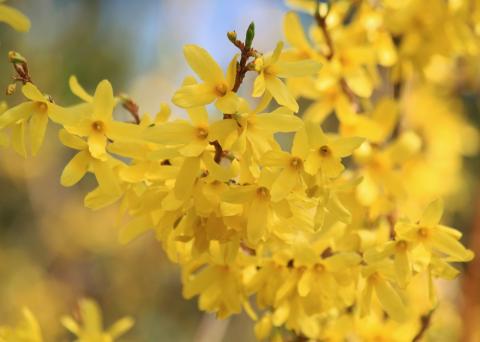Forcing Branches Indoors

One way to speed the seemingly interminable winter months is to bring spring indoors by “forcing” forsythia and other spring-blooming branches. In other words, tricking them into believing spring has arrived by exposing them to the warmth of the indoors. Forcing branches is a wonderful way to brighten up your indoor space and remind yourself that spring will indeed arrive once again.
Spring-blooming ornamental trees and shrubs such as lilacs, crabapples, and forsythia set their flower buds during the previous growing season, but must experience a period of dormancy (usually about six weeks) before they will bloom. Buds typically come out of dormancy two or three weeks after being exposed to warmth and moisture. You can speed up this process by cutting some branches and bringing branches indoors. Forsythia usually blooms in April but can be forced to bloom in late February or March. Since late winter is the best time to prune deciduous trees and shrubs anyway, why not use some of the cuttings to brighten your home afterward?
Try to prune on a mild winter day when the temperature is above freezing, as branches and buds are softer, more pliable, and will be better able to make the transition from cold outdoor temperatures. Note that shrubs that were pruned the previous season after bud set will not flower well, and are therefore not good candidates for forcing. Select branches that are at least 12 inches long and less than ½ inch in diameter (about the diameter of a pencil) with lots of plump flower buds (Flower buds are round and fat, whereas leaf buds are smaller and pointed). If you’re not sure what type of buds you are looking at, slice one open to see if there are miniature flower parts inside.
Once indoors, cut branches to the desired length, keeping in mind that a mix of lengths makes a nice display. Strip buds, twigs, and leaves from the part of the stem that will be under water. Then place the branches upright into a vase or bucket of warm water, cutting another inch off the bottom of each while keeping it submerged in the water to prevent air from entering the stem and blocking water uptake. Place the container in a warm room (60 to 70 °F) out of direct sunlight and change the water every few days to limit bacterial growth. Once the flowers have started to “pop”, arrange branches in a tall, water-filled vase and set in a bright but cool (50 to 70 °F) spot out of direct sunlight. The cooler the spot, the longer the branches will bloom.
Almost any spring flowering shrub or tree can be forced indoors. If you have some of these plants in your own yard, try cutting a few branches and bringing them inside:
- Forsythia
- Bush Honeysuckle
- Crab Apple
- Flowering Cherry
- Flowering Quince
- Willow
- Flowering Dogwood
- Fothergilla
- Redbud
- Witch hazel
- Magnolia
- Red Maple
If you try to force a particular plant into bloom and it doesn’t work after three or four weeks, try again; it may have been too early. The closer to the plant’s natural bloom time it is brought indoors, the faster it will bloom. While Forsythia may be forced to bloom in 1 to 3 weeks, it may take crab apples or magnolias as long as 4 to 5 weeks.
Enjoy these beautiful and often scented blossoms inside your home as you wait for the arrival of spring!
UNH Cooperative Extension Master Gardener volunteers share information about home, yard, and garden topics with the people of New Hampshire. Got questions? Master Gardeners provide practical help finding answers to your questions through the Ask UNH Extension Infoline. Call toll free at 1-877-398-4769, Monday to Friday, 9 a.m. to 2 p.m., or e-mail us atanswers@unh.edu.

